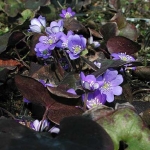| Common Name: |
Liverleaf |
| Other Names: |
European Liverwort, Kidneywort |
| Botanical Name: |
Hepatica nobilis syn H. triloba, Anemone hepatica |
| Genus: |
Hepatica |
| Family: |
Ranunculaceae |
| Native Location: |
Europe |
| Cultivation: |
Deep, moist, rich, alkaline soil in shade. Thrives in heavy soils. Dislikes disturbance. |
| Propagation: |
By seed sown when ripe (species only); by division in spring. |
| Harvest: |
Plants are cut from late spring to mid-summer and dried for use in infusions, liquid extracts, and tinctures. |
| Height: |
8-10cm (3-4in) |
| Width: |
15cm (6in) |
| Variations: |
Rubra Plena
Has double, deep purple-pink flowers. It is less vigorous than the species, and needs careful cultivation.
Height: 8cm (3in)
Width: 10-12cm (4-5in) |
| Hardiness: |
Z4-8 |
| Parts Used: |
Whole Plant |
| Properties: |
An astringent, diuretic, antibiotic herb that acts as a mild tonic for the liver and the digestive and bronchial systems. It also promotes healing. |
| Medicinal Uses: |
Internally for bronchial and digestive complaints, and liver and gall bladder disorders. Externally for minor injuries and ringworm. It is little used today. |
| Bibliography: |
Encylopedia of Herbs by Deni Brown Copyright ©: 1995, 2001 Dorling Kindersley Limited pp 233-234
|
